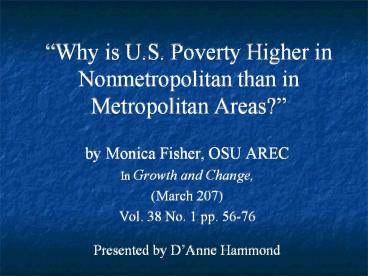PowerPoint PPT Presentation
1 / 12
Title:
1
Why is U.S. Poverty Higher in Nonmetropolitan
than in Metropolitan Areas?
- by Monica Fisher, OSU AREC
- In Growth and Change,
- (March 207)
- Vol. 38 No. 1 pp. 56-76
- Presented by DAnne Hammond
2
Rural/Urban Poverty, Fisher
- Examines whether the difference in poverty levels
reflects personal choice in addition to
structural explanations of limited economic and
social opportunities. - i.e. structural condition and sorting hypothesis?
3
The question
- ...asking if the disproportionate poverty in
non-metro places partly reflects attitudes of
people with personal attributes related to
poverty they may be attracted to non-metro
places or otherwise reluctant (or unable) to
leave them.
4
Observable differences in poverty rates
- Other research shows the odds of being poor are
1.2 to 2.3 times higher in rural areas - 1/20 metro counties poverty rate 20 or higher
- 1/5 non-metro counties poverty rate 20 or higher
5
Theoretical model
- y f (age female/not white/not education
unemployed/not in labor force/not retired
disabled married household size young child
present/not non-metro/not) - where y adj. income-needs ratio
6
Method
- Series of multivariate regression models using
OLS to model poverty across place - All models are variations of
- y1 a0 a1xi a2ni a3si ei
- Where y pretax income-to-need need is
census-based poverty threshold - x individual factors race, age, gender,
presence of children, etc. - n binary variable indicating non-metro
- s fixed-effects controlling for state-level
expenditures, tax structure, etc. - e error term, assumed to be i.i.d.
7
Variable y
- Dependent variable y (income-to-need) is adjusted
for housing cost differences using fair market
rent values (FMR) - Persistent differences in housing costs between
metro and non-metro
8
Data source
- Panel Study of Income Dynamics (PSID)
- Nationally representative sample
- Longitudinal data
- Survey following apx. 5,000 families since 1968
- This research uses the nine panels between 1985
and 1993 that include non-metro variable
9
Data subsample
- Household min. 2 yrs. observations in study
- Restricted to lower income distribution
- Records must have complete data for all variables
- Head of household is a proxy for entire household
- Result is sample of 2,007 household heads in
poverty in 1993 and at least one other year
between 1985 and 1993 - Average number of years in sample 7
10
Final data set characteristics
- Differences (statistically significant) between
whole sample and selected sub-sample - Female
- With young child
- Non-metro area
- More likely non-white and unemployed
- Lower education levels
11
Results
- F-stat indicates joint significance of
explanatory variables (95 ci) - Indirect evidence supporting both structural
condition hypothesis and self-sorting to
non-metro - Metro to non-metro movers have increased
income-needs ratio of 25 - Non-metro households economically worse off
(ceteris parabus)
12
Policy Implications
- Further empirical studies on place-level and
individual-level variables over time - ...can improve the design of anti-poverty
policy, providing insights on what combinations
of human-capital and community-strengthening
policies are most likely to reduce non-metro
poverty and its unfavorable consequences. (p.
73)

